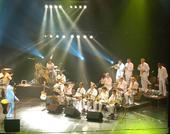Myspace Layouts - Myspace Editor
Mizikopéyi est le premier Big Band de musique antillaise contemporaine (biguine, mazurka, zouk…). Dans « Diamant des Îles », une version « Big Band » d’une chanson de Paulo Rosine (leader du groupe Malavoi), « Flè bô caille » était proposée. Des arrangements "Big Band" étaient aussi présentés dans « Musi-Qualité », sur "Lè siel si ba", chanson de Chris Combette. Il était temps pour moi de me produire sur scène dans un répertoire complètement adapté à un groupe style « New Orleans ». Des concerts basés sur cette production sont du domaine de l‘inédit au niveau mondial. De la musique antillaise exécutée par quelques-uns de ses meilleurs musiciens, en Big Band (12 cuivres et 5 musiciens, Mizikopéyi Big Band), pour une prestation des plus élégantes et d’une qualité musicale extraordinaire. Un mélange des percussions traditionnelles des Antilles (gwoka, chouval bwa…), des rythmes populaires de la Martinique (zouk, biguine, mazurka, konpa…), en harmonie avec un pupitre de cuivres dans la grande tradition de la Nouvelle Orléans, voilà le défi que nous avons tenté de relever. Issus pour la plupart de la Martinique, les musiciens talentueux qui composent Mizikopéyi font leurs preuves avec des artistes de renommée internationale. Ce sont les Thierry Vaton, Pierre-Michel Balthazar dit Bago, Patrick Boston, Thierry Fanfant, Jean-Philippe Fanfant, Alain Ravaud qui viendront défendre la qualité de la création martiniquaise d’aujourd’hui dans cet exercice si particulier de l’arrangement Big Band. La section de cuivres est elle-même composée de musiciens réputés au niveau européen, tels que Allen Hoist, Bernard Camoin, Pierre Mimran, Olivier Defays, Erick Poirier, Thierry Farrugia, entre autres. Thierry Vaton, Thierry Fanfant, Alain Ravaud, Philippe Slominski, Christian Martinez, et nouveau venu, Paco Man'Alma, originaire lui aussi de Martinique, tous se sont pliés à l'exercice de l'arrangement et de l'écriture Big Band, dont la difficulté fût de garder aux chansons les plus connues de mon répertoire leurs aspects familiers, que le public ne soit pas perturbé et ne s'y retrouve plus, tout en y intégrant les 12 cuivres. Il ne vous reste plus qu'à faire vous-même en concert l'expérience de la musique antillaise en Big Band. À bientôt, donc…Mizikopéyi is the first Big Band of contemporary West-Indian music (beguine, mazurka, zouk...). In the "Diamant des Îles" cd, a "Big Band" version of Paulo Rosine's song (leader of the Malavoi group), "Flè bô caille", was included.A Big Band arrangement was also featured on the "Musi-Qualité" cd, "Lè siel si ba", a Chris Combette's song. It was time for me to perform on stage with a repertoire completely performed by a "New Orleans" style group. Concerts on this kind of production are unreleased and new on a world level. West-Indian music carried out by some of its best musicians, in a Big Band (made up of a 12 piece horn section and 5 musicians in the rhythm section) for the most elegant show added to extraordinary musical quality. A mixture of the traditional percussions of the Antilles (gwoka, chouval bwa...), popular rhythms of Martinique (zouk, beguine, mazurka, konpa...), in harmony with a horn section from the great tradition of New Orleans, this is the goal that we tried to achieve. The majority coming from Martinique, the talented musicians who compose Mizikopéyi are used to backing up artists of international fame. It is Thierry Vaton, Pierre-Michel Balthazar aka Bago, Patrick Boston, Thierry Fanfant, Jean-Philippe Fanfant, Alain Ravaud who will come to defend the quality of today’s Martinique creativity in this very unusual exercise of Big Band arrangements. The horn section also gathers famous musicians, known all over Europe, Allen Hoist, Bernard Camoin, Pierre Mimran, Olivier Defays, Erick Poirier, Thierry Farrugia, amongst others. Thierry Vaton, Thierry Fanfant, Alain Ravaud, Philippe Slominski, Christian Martinez, and newcomer, Paco Man'Alma (also a native from Martinique), all yielded from the exercise of arrangement and score writing for a Big Band, whose difficulty was to keep the familiar aspects of my most recognizable songs, so that the public might not be disturbed and also easily recognize them, while integrating the 12 piece horn section. It's now up to you to “taste†this vision of West-Indian music in concert. See you soon…